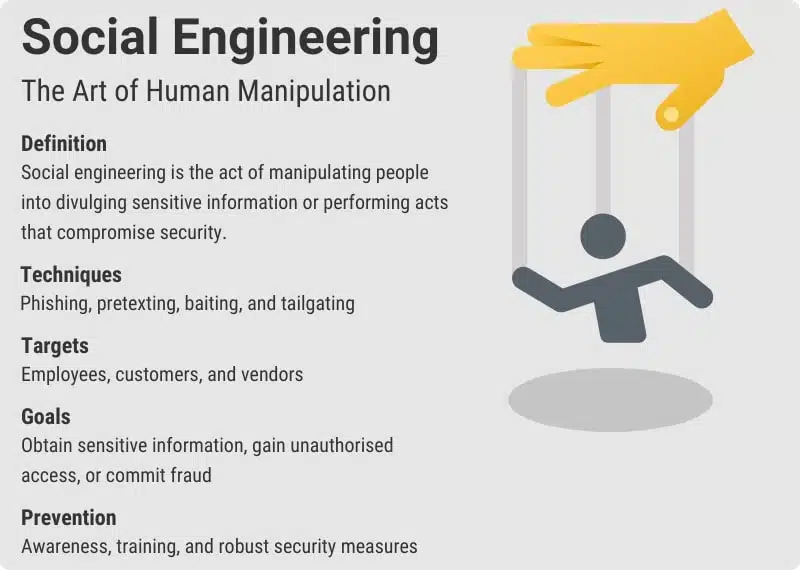
Introduction to Social Engineering
In the vast realm of cybersecurity, one term that often takes center stage is “Social Engineering.” But what exactly is it? Well, think of it as the art of manipulating individuals to divulge confidential information or perform actions that may not be in their best interest. Understanding social engineering is crucial because, in today’s digital age, cybercriminals have become adept at exploiting human psychology for their nefarious purposes.
Types of Social Engineering
Phishing Attacks One of the most common forms of social engineering is phishing attacks. Here, cybercriminals masquerade as trustworthy entities via emails or messages, tricking unsuspecting individuals into providing sensitive information like login credentials or financial details.
Pretexting Pretexting involves creating a fabricated scenario to obtain personal information from a target. For example, a cybercriminal might pose as a bank representative and call a victim, claiming there’s an issue with their account to extract confidential data.
Baiting Similar to its name, baiting involves luring victims into a trap by offering something enticing. This could be in the form of free software downloads or promising rewards in exchange for personal information.
Tailgating Ever held the door open for someone behind you without verifying their identity? That’s essentially what tailgating is in the context of social engineering. It involves an unauthorized individual gaining physical access to a restricted area by following closely behind an authorized person.
Spear Phishing Spear phishing is a more targeted form of phishing where cybercriminals tailor their messages to specific individuals or organizations, making them appear more authentic and increasing the likelihood of success.
Common Techniques Used in Social Engineering
Authority Exploitation People tend to comply with requests from authority figures without question. Cybercriminals capitalize on this tendency by impersonating figures of authority like IT support or company executives to manipulate individuals into divulging sensitive information.
Scarcity Principle The fear of missing out is a powerful motivator. Cybercriminals exploit this by creating a sense of urgency or scarcity, such as claiming limited-time offers or threatening immediate consequences if action isn’t taken, to prompt individuals to act hastily without considering the consequences.
Reciprocity Reciprocity is the notion of feeling obligated to repay a favor. Cybercriminals may exploit this by offering something of perceived value upfront, like free downloads or gifts, with the expectation of receiving something in return, such as personal information or access to sensitive data.
Fear and Intimidation Fear is a potent tool in the hands of social engineers. By instilling fear or intimidation through threats of legal action, financial repercussions, or personal harm, cybercriminals coerce individuals into compliance, bypassing their rational decision-making processes.
Real-Life Examples of Social Engineering Attacks
Targeting Individuals In 2016, a widespread phishing campaign targeted Gmail users, convincing them to click on a fake Google Docs link, granting access to their email accounts to cybercriminals.
Targeting Organizations The infamous CEO fraud, where cybercriminals impersonate high-ranking executives to authorize fraudulent money transfers, has cost businesses billions of dollars in losses worldwide.
Impact of Social Engineering Attacks
Financial Losses loveblog.xyz attacks can result in significant financial losses for both individuals and organizations, ranging from unauthorized transactions to fraudulent wire transfers.
Data Breaches By tricking individuals into divulging login credentials or other sensitive information, social engineering attacks pave the way for data breaches, exposing confidential data to unauthorized parties.
Reputational Damage The fallout from a successful social engineering attack extends beyond financial losses. Organizations may suffer reputational damage, eroding customer trust and loyalty, which can have long-term consequences for their business viability.
Preventive Measures Against Social Engineering
Employee Training Educating employees about the various forms of social engineering and how to recognize and respond to them is critical in mitigating the risk of successful attacks.
Multi-Factor Authentication Implementing multi-factor authentication adds an extra layer of security by requiring additional verification beyond passwords, making it more challenging for cybercriminals to gain unauthorized access.
Regular Security Audits Conducting regular security audits helps identify vulnerabilities and weaknesses in existing systems and processes, allowing organizations to take proactive measures to strengthen their defenses against social engineering attacks.
Social Engineering in the Digital Age
Role of Social Media Social media platforms provide a treasure trove of personal information that cybercriminals can exploit for social engineering purposes, making it imperative for individuals to exercise caution when sharing personal information online.
Online Impersonation With the rise of online communication channels, cybercriminals can easily impersonate individuals or organizations to deceive unsuspecting victims, highlighting the importance of verifying the authenticity of online interactions.
Legal and Ethical Implications of Social Engineering
Privacy Concerns Social engineering attacks raise significant privacy concerns, as they often involve the unauthorized collection and misuse of personal information without individuals’ consent.
Compliance Regulations Organizations may face legal and regulatory consequences for failing to protect sensitive information from social engineering attacks, emphasizing the need for compliance with data protection laws and regulations.
The Future of Social Engineering
Evolving Tactics As technology evolves, so too will the tactics used by cybercriminals in social engineering attacks, necessitating continuous adaptation and innovation in cybersecurity strategies.
Technological Advancements Advancements in artificial intelligence and machine learning offer both opportunities and challenges in the fight against social engineering, as cybercriminals leverage these technologies to create more sophisticated and convincing attacks.
Conclusion
In conclusion, social engineering remains a pervasive threat in today’s interconnected world, leveraging human psychology to bypass technical security measures. By understanding the various types of social engineering tactics, implementing preventive measures, and staying vigilant, individuals and organizations can better protect themselves against these insidious attacks.
